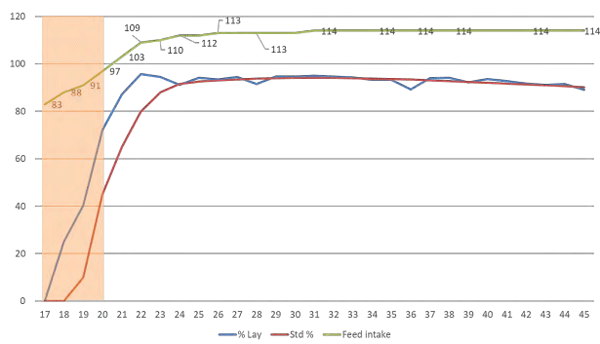I. INTRODUCTION
The continuous genetic improvements are increasing the first commercial egg size produced and extending the production life of the layer hens worldwide. These improvements are related to what happens at rearing and at the start of the production. Early studies showed that while approximately 60 to 75% of the calcium destined for the shell comes directly from intestinal absorption (Driggers and Comar, 1949), up to 36% could be traced to bones (Mueller et al., 1964). This bone source is critical since shell calcification occurs during the dark period, when the hen is not eating. Proper skeletal development is integral during pullet growth, which has a first period of growth during the first 6 weeks of rearing and a second period of growth with long bones reaching their maximum length and cortical bone reaching optimal thickness by week 22 of age (Whitehead and Fleming, 2000). Upon activation of the reproductive axis and in preparation for the laying cycle, increasing estradiol 17-beta (E2) concentrations shift the activity of osteoblasts toward the formation of medullary bone (Miller, 1992), with cortical bone accumulation terminated before lay (Hudson et al., 1993). This medullary bone is deposited on the interior, endosteal surface of the cortex in the marrow cavities of long bones (Mccoy and Reilly, 1996), with the largest reserve in the femur, followed by the tibia (Clunies et al., 1992). This second phase of calcium deposition is very dependent of the feed intake at the start of production. Nutritionists have different approaches when the start of production happens in layer hens and today there is a new option suggested by H&N International called Hybrid Feed that aims to support the start of production better than current and traditional approaches.
II. CONCEPT OF HYBRID FEED
The feed intake development at the beginning of production will allow the bird to have the correct nutrient intake. This feed aims to keep developing the feed intake as it happens at the end of rearing of the pullet and supply enough nutrients to support the bone development and the production of the first egg. The numbers recommended in the Hybrid Feed should be adapted to the different raw material information sources and to the available raw materials in the market. Here below a description of the principals and recommendations when developing a Hybrid Feed:
- Low energy diet: the feed intake of the layer hens is regulated by calories intake (A.S. Hussein et al 1996). During the developer phase of the pullet the feed should focus in developing the feed intake capacity of the bird, the metabolizable energy content of the Hybrid Feed should be like the developer feed, around 2650-2750 kcal/kg, depending on the source/s of information used to evaluate the energy of the raw materials. This approach stimulates the feed intake at the start of the production, and it will not hurt the start of the production because the production needs are still low, and the feed intake and composition of the Hybrid Feed will provide the necessary nutrients.
- Fibre content of the diet: low density diets will be completed by fibre. There are different ways we can classify the type of fibre (M. Chot 2015); it was shown that with the commonly used raw materials in layer hen diet, the increase of the crude fibre has a positive effect in gut development and therefore the feed intake capacity of the birds (Kondra et al 1974).
- Amino acids level: the amino acids level is like the layer phase 1 recommendation. There will be enough amino acids for body weigh growth and egg production. The amino acids requirements aren’t maximum until week 22-23 of age as the flock is in full production (Table 1). However, due to the low feed intake it is necessary to have a high concentration of the amino acids to be sure that there will be an enough supply.
Table 1 - Requirements of digestible Lysine at the start of egg production, H&N International 2019.
- Calcium level: the average hen requires 2.2 g of calcium for each eggshell formation (Bouvarel et al., 2011). At the start of production, we will have a growth of the bones and we will have some early productive hens. As per the bone development with 2-2.5% of calcium level would be enough, however the early producing bird need more. Therefore, the recommendation is to formulate to 3.8% Ca in browns and 4% in whites layer hens. What is important is the source of calcium, to avoid possible feed refusal the coarse calcium carbonate should be the 60-70% of the total calcium carbonate in the diet. The particle size of the coarse calcium carbonate should be 2-4 mm.
- Phosphorus level: the phosphorus level in poultry is related to the feed intake and the growth of the birds, critical in this stage and in layer hens it is related to the calcium deposition in the bones (J.D. Summers et al 1976). Therefore, the level of available phosphorus should be as high as in the layer phase 1 recommendation, 0.44 % in browns and 0.46 % in whites.
- High level of salt: the salt is a raw material related to the feed intake in birds. It has been shown that salt stimulates the water intake and feed intake. Therefore, it is recommended to include salt at the level of 0.28%. It shouldn’t be replaced with a level of sodium in the diet. The use of sodium bicarbonate as raw material in the layer diets could complete the needs of sodium requirement in the diet but it doesn’t have the same feed intake stimulation effect as the salt. Therefore, it will be important to be sure that we have the level of salt in the diet, and we don’t exceed the maximum of 0.34% of chloride as nutrient.
All this parameter will make the diet, but it is also about the use at the farm.
III. USE OF HYBRID FEED
There are challenges at the farm when getting accurate data at the start of production. The long transfer period from rearing to production house and the stress of the arrival make it difficult to calculate the feed intake at the start of production. In addition, the low production of the flock delays the egg collection of the flock, therefore we don’t have an accurate data of the daily production.
The use of Hybrid feed meant to be simple and easy to apply, therefore this is the recommended program:
1. House the pullets in production with Rearing Development feed, as long as there wasn’t a previous light stimulation of the flock at rearing.
2. Hybrid feed should be available to the hens as soon as the light stimulation is given to the pullets.
3. Hybrid feed will be provided until 70% of production is achieved. This will happen around the week 21-22 of age and it will be easy to have an accurate data of the % of production as the egg collection is regularly done at the farm at this age. The feed intake by then will be around 95-100 grams/hen and even higher if the pullet had a good feed development.
4. The next feed should be a 60-58 egg mass target feed as the egg production will reach the peak.
IV. ADVANTAGES OF HYBRID FEED
There are other approaches during the onset period like using a pre-lay feed and/or a super-starter feed. Both approaches have shortcomings that Hybrid Feed doesn’t and has all the advantages of a pre-lay or super-starter feed.
The pre-lay feed is meant to be a transition feed between pullet and production, however the application at the farm level is very difficult and dangerous. The pre-lay feed use is recommended to do by two ways, and both are difficult to apply:
- Use of pre-lay until 2-5% of production: this recommendation doesn’t consider that many farms don’t collect the eggs daily when the flock is starting in production. The egg collection is decided by the workload at the farm and how the egg collection belts look like; therefore, a lot of mistakes can happen. The pre-lay diet can be extended too long and early producer hens can become decalcified, stop the production and in the peak of production we will have peaks of production 2- 5% lower than the standard.
- Use of pre-lay 0.5-1 kilogram per bird: this recommendation forgets that there is variation of the feed intake at the pullets due to effect of weather changes and feed development challenges during rearing. This recommendation will have same result as the previous one and even we can have problems of eggshell quality late in production.
Another approach is using a super starter of lay after the developer feed or after the use of the pre-lay. This super starter of lay is highly concentrated feed in nutrients and very expensive; it is designed for supplying all the nutrients needed at this critical moment. However, it creates new challenges: the high energy of this feed restricts the feed intake development of the layers, therefore, many times the birds don’t have enough nutrient intake at the peak of the production; it will lead to production drop at the peak of the production when changing to a layer 1 diet because of lack of feed intake; or it will push the farmer to use an expensive feed until 40 weeks of age because the layer hen doesn’t eat enough nutrients.
The hybrid is a proven alternative that skips the disadvantages of the other recommendations and has all the advantages (Table 2). The use is very friendly for the farmers and it gives a more cost effective solution for the start and peak of the production.
Table 2 - Comparison of the different effects of the three options at the start of lay.
V. EXPERIENCE OF HYBRID FEED
The use of Hybrid Feed started in 2019 and it keeps increasing the acceptance as it is tested by the egg producers. This feed was tested in Australian conditions in caged brown birds and cage free brown birds; at that time, we could see a good feed intake development, performance of the birds was on standards (Graph 1) with good eggshell quality. There are more positive experiences when using Hybrid feed in brown layer markets like Colombia or Ecuador and in white markets like in USA and Canada.
Figure 1 - Production performance and feed intake when used Hybrid Feed from 17 to 20 weeks.
VI. CONCLUSIONS
The use of the Hybrid Feed is a new approach to the start of production where different challenges happen. This new approach can replace the previous practices that are difficult to apply at farm level or are too costly. The use of the Hybrid Feed should be part of the feed intake development program where first step starts at the develop phase of the pullet. At this stage there should be a feed intake capacity development and later at start the production Hybrid Feed will be the perfect match for having a bone development, sexual maturity growth and first egg production. The Hybrid Feed brings solutions to a critical part of the egg production, the start of production, no matter the breed.
Presented at the 34th Annual Australian Poultry Science Symposium 2023. For information on the latest edition, click here. 












.jpg&w=3840&q=75)